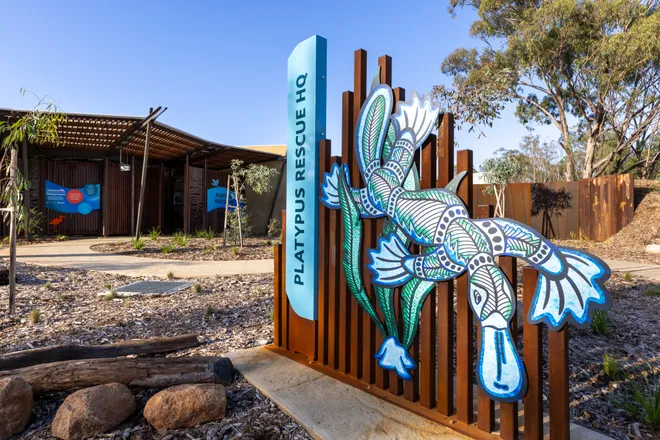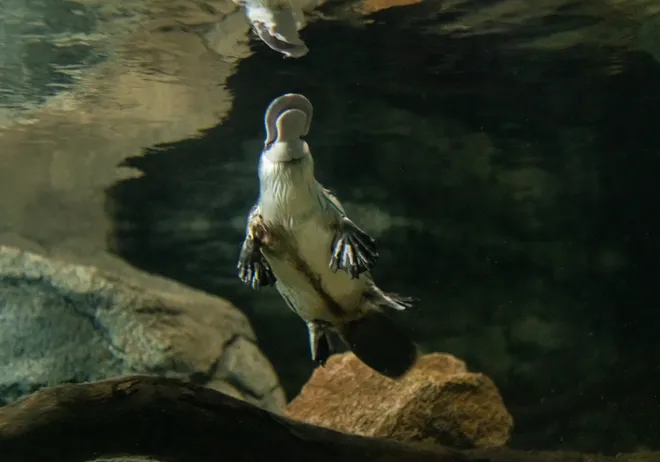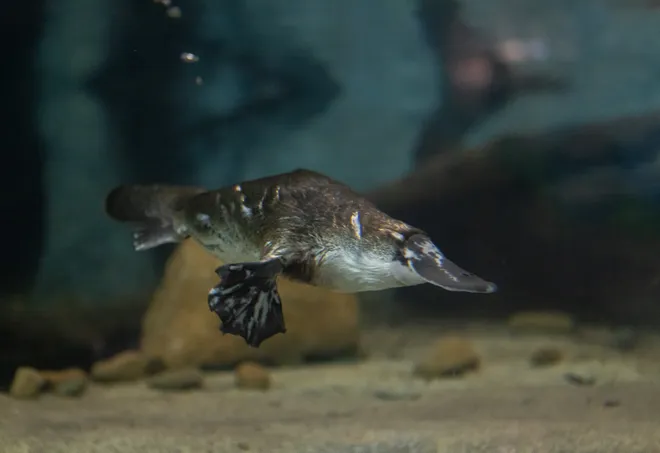The oddball platypus is in trouble. Researchers have a plan to help.
You might know the platypus as Australia's iconic shy, duck-billed, beaver-tailed, otter-footed, egg-laying mammal. Unfortunately, the odd animal is also struggling to survive.
This is why Australia and the San Diego Zoo Wildlife Alliance have set up a new breeding center to figure out how to help the unique, strange-looking creatures breed in captivity.
They're fascinating, said Hendrick Nollens, vice president of Wildlife Health with San Diego Zoo Wildlife Alliance. "It's like someone created all the animals and then had these leftover pieces and stuck them all together and created the platypus."
"The population is believed to be about 50% of what it once was," he said. "They're clearly on a significant downward trend."
Australia's Taronga Western Plains Zoo, with help from San Diego, this month created a new rescue and breeding center to figure out how to help the unique, strange-looking creatures breed in captivity.
The plan began after Australia's Black Summer of bushfires in 2019-2020 when the Taronga Zoo was asked to rescue platypuses caught in the fires.
“In 2019-2020, we saw just how vulnerable platypus are to prolonged drought, megafires and floods, which are only going to become more common as a result of a changing climate,” said Taronga and University of New South Wales research associate Tahneal Hawke.
They realized they needed a rescue facility, said Nollens.
"If there's an area under a prolonged drought or a fire watch, the idea is you can go get everybody in a particular area and bring them in to protect them and then have them go home again when the danger is passed," he said.
The Platypus Rescue HQ at Taronga Western Plains Zoo in Dubbo, Australia, got its first four animals earlier this month. Eventually, it will be able to house as many as 64.
Not only will it house platypuses who are in danger but it will also provide a facility to study their breeding behavior, biology and the genetic structure of their population.
"No one has cracked the code to understand what conditions you have to prepare to get a platypus to breed," Nollens said.
Since 1943, only 23 puggles (as baby platypuses are known) have been born in zoos. As the animals' geographic range in Australia has declined 21% and is expected to decrease by 40% in the next 50 years, helping them in the wild and in zoos is critical. The shrinking is due to climate change and habitat destruction due to human activities.
The San Diego Zoo and Wildlife Alliance are involved because the two have been sister zoos for decades. In 2019, San Diego got two platypus, the only two known to live outside of Australia.
"We'll work on understanding breeding hormone analysis and population genetics structure," said Nollens. "For example, what hormones can you look for in feces and urine, so you can monitor their levels without the platypus knowing you're collecting anything."


Platypuses are just plain weird
Platypuses are a little smaller than housecats and one of the odder animals to roam the earth. To start with, they're mammals that lay eggs, one of only five such creatures, called monotremes, in the world.
They live in rivers and wetlands, rummaging around the bottoms for insects, shellfish, and worms. They are nocturnal and like to live in murky waters.

To do so, they use a rare and special sixth sense called electroreception. Platypus bills contain specialized nerve endings that detect the tiny electrical currents generated by the muscular contrast of their prey.
"They're designed not to be seen," said Nollens. "They're brown and very quiet. They travel in these murky water systems so instead of eyesight, they use their neuroreceptors to find their prey. In that regard, they're somewhat similar to sharks."
As ugly-cute as they are, platypuses are not kind and cuddly.
The males are one of the only venomous mammals, equipped with sharp spurs on their hind feet that are covered with a clear, slightly sticky fluid akin to snake venom that causes severe pain and swelling in victims who are scratched.
Should you ever need to pick up a platypus (and experts suggest you shouldn't, for its health and yours), the only safe way to do so is to grab the end of its tail to avoid being "spurred," according to the Australian Platypus Conservancy. Not the base, which could still allow the animal to kick at you with its venomous spurs.
“Platypuses play a crucial role in maintaining the health of their native watersheds and uniquely contribute to our planet’s biodiversity,” said Nollens. Plus," he said, they're charismatic because they're so interesting.
"Every child knows what a platypus is."
Disclaimer: The copyright of this article belongs to the original author. Reposting this article is solely for the purpose of information dissemination and does not constitute any investment advice. If there is any infringement, please contact us immediately. We will make corrections or deletions as necessary. Thank you.

